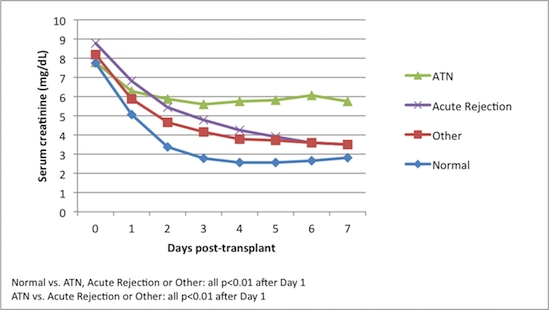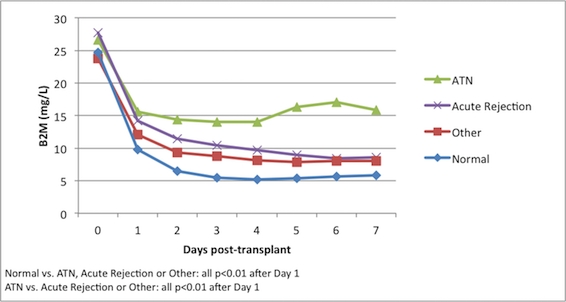Post-Transplant Changes in Serum Creatinine and Beta-2 Microglobulin Predict Acute Tubular Necrosis in the Early Post-Transplant Period
1Department of Medicine, University of Wisconsin School of Medicine and Public Health, Madison, WI
2Department of Surgery, University of Wisconsin School of Medicine and Public Health, Madison, WI.
Meeting: 2015 American Transplant Congress
Abstract number: A36
Keywords: Graft function, Kidney transplantation, Monitoring, Renal injury
Session Information
Session Name: Poster Session A: Delayed Function/Acute Injury/Outcomes/Glomerulonephritis
Session Type: Poster Session
Date: Saturday, May 2, 2015
Session Time: 5:30pm-7:30pm
 Presentation Time: 5:30pm-7:30pm
Presentation Time: 5:30pm-7:30pm
Location: Exhibit Hall E
Purpose: To evaluate the utility of early post-transplant changes in serum creatinine (SCr) and beta-2 microglobulin (B2M) in differentiating acute tubular necrosis (ATN) and other causes of renal allograft dysfunction in the first month after transplant.
Methods: SCr and B2M were measured daily for the first week after transplantation in 3641 renal transplant recipients between 1994 and 2012. Biomarker levels at Day 3 and changes from post-transplant Day 1 to Day 3 were examined to determine their ability to discriminate between causes of allograft dysfunction on biopsy from Day 4 to Day 30, including ATN and acute rejection (AR). Stage 1 predicted incidence of any biopsy proven abnormality. Stage 2 predicted ATN among individuals detected in Stage 1 as having any abnormality.
Results: 249 (6.8%) patients had ATN, 161 (4.4%) had AR, 661 (18.2%) had other pathology and 2570 (70.6%) had no abnormality within the first post-transplant month. SCr and B2M levels differed by presence and type of abnormality significantly starting at Day 2, with the highest levels and least steep slopes in those with ATN (p<0.01) and lowest in those with no abnormality (p<0.01) [Figures 1 and 2]. The Stage 1 model including SCr and B2M on Day 3 and changes in SCr and B2M values from Day 1 to Day 3 had an AUC of 0.692. The similar Stage 2 model achieved an AUC of 0.724. 

Conclusion: Our findings suggest that monitoring early values and changes in SCr and B2M can identify patients who are at higher risk of developing post-transplant abnormalities, including ATN, and may allow for earlier initiation of prevention and therapy.
To cite this abstract in AMA style:
Liu P, Djamali A, Kaufman D, Astor B. Post-Transplant Changes in Serum Creatinine and Beta-2 Microglobulin Predict Acute Tubular Necrosis in the Early Post-Transplant Period [abstract]. Am J Transplant. 2015; 15 (suppl 3). https://atcmeetingabstracts.com/abstract/post-transplant-changes-in-serum-creatinine-and-beta-2-microglobulin-predict-acute-tubular-necrosis-in-the-early-post-transplant-period/. Accessed December 26, 2025.« Back to 2015 American Transplant Congress
